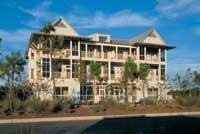Connecting Communities Landscaping brings more than beauty to multifamily developments; it also connects apartment buildings and their residents to the larger community. In Wilmington, Del., Christina Landing, an 8-acre site that will have a 22-story residential tower and 63 townhomes, is converting part of the former brownfield into a park along the Christina River walkway.
“We worked hand in hand with the city of Wilmington to have our park area contribute to the river walk they are developing,” says Robert Maloney, landscape architect with Kling, a full-service design firm located in Philadelphia. Maloney notes that the city will benefit from the new park, while Christina Landing residents will have direct access to the river walk. With downtown Wilmington just across the river, Christina Landing will allow pedestrian and bicycling commuting to work and cultural events. The community is scheduled to open in 2005.
Visually, the walk will complement and contrast with the river walk. “To maintain consistency, we used similar light standards and paving,” says Maloney, who also saved money and differentiated Christina Landing from the river walk by specifying concrete sidewalks outlined with the bricks of the same style used in the public areas.
AvalonBay, which often incorporates commercial or live/work space in its developments, also likes to encourage pedestrian activity. “We want to have some retail functions and park-like activity along with our residential so people don’t have to drive around in their cars a lot after they come home,” Willden says.
This was a goal at WaterColor, as well, where master planner and architect Jaquelin Robertson allowed for 100,000 square feet of retail; 8 miles of bicycling and walking paths; an outdoor amphitheater that seats 1,200 for movies, concerts, and plays; and a boathouse with kayaks, canoes, and other watercraft. The more than 120 units of multifamily housing were concentrated in the Town Center to create an urban feel and density that contributes to the concept of “downtown” WaterColor. The multistory buildings with two-, three-, and four-bedroom condominiums not only create a visual focus but provide a diversity of housing stock that allows a dynamic mix of residents to contribute to the community.
“Half the people in [neighboring] Seaside on a Sunday afternoon are shopping and will get in their cars and drive home in the evening,” says Jim Pettigrew, a sales associate at WaterColor. “Here, people are happy to leave their cars parked for four or five days and walk or ride bikes where they want to go.” Dedicating almost half the community to open space reduces the amount of development on the land but increases the recreational activity options for residents.
Say It With Flowers When open space is an unattainable luxury, though, landscaping still matters. At Rainier Court in Seattle, the Johnson Braund Design Group has designed an active urban community that makes the most of the limited available land. Easter says the mixed-use development with 208 units of affordable senior housing and 178 units of affordable family housing also includes almost 20,000 square feet of commercial space to encourage residents to walk instead of drive and to increase security with active streetscape. Whereas developments like WaterColor can take advantage of large open spaces, Easter had to create a level of visual separation and beauty with the landscaping plan there.
“When you have many units stacked over the courtyard, what you see from the upper decks and courtyards has to be visually interesting even when viewed from above,” Easter says. He accomplished that through a variety of paving patterns and plantings used to decorate the development’s courtyard. Trellises add both visual interest and a measure of privacy. “In Rainier Court, we created a sculptural look with trellises painted metal to match buildings, but when they are filled with plantings, they create a psychological separation between units and semi-public areas,” Easter says, pointing to landscaping’s ability to create distinct spaces in crowded areas.
For high-rise residences in Chicago and the surrounding suburbs, David Gantt, a vice president with the John Buck Co., a Chicago-based developer and manager of commercial property and luxury rental apartments, uses simple landscaping practices to make a visual statement. At the Park Evanston, a 24-story tower with a retail and parking garage base, Gantt has created a cascade of petunias along the garage’s façade. “For less than $1,000 a year in petunias and a simple mist watering system that you can pick up at a Home Depot, we have created a striking statement that enhances the building and the natural food message of Whole Foods, our major retailer,” Gantt says.
At Plaza 440, a 457-unit market-rate building in Chicago, Gantt wanted to increase retention rates before selling the property. Of the $150,000 in improvements to common areas, approximately half was spent on landscaping improvements at the pool deck. “Most of the money was spent on the pool renovation,” Gantt says, “but the most efficient way of creating a ‘wow factor’ was with aromatic dwarf lilacs and river birch in containers and vinca vines and begonias in secured pots.” According to the executive, the improvements helped boost retention rates from 45 to 75 percent and contributed to more than $20 million in profit when the building sold.
Not bad for a bunch of begonias.
